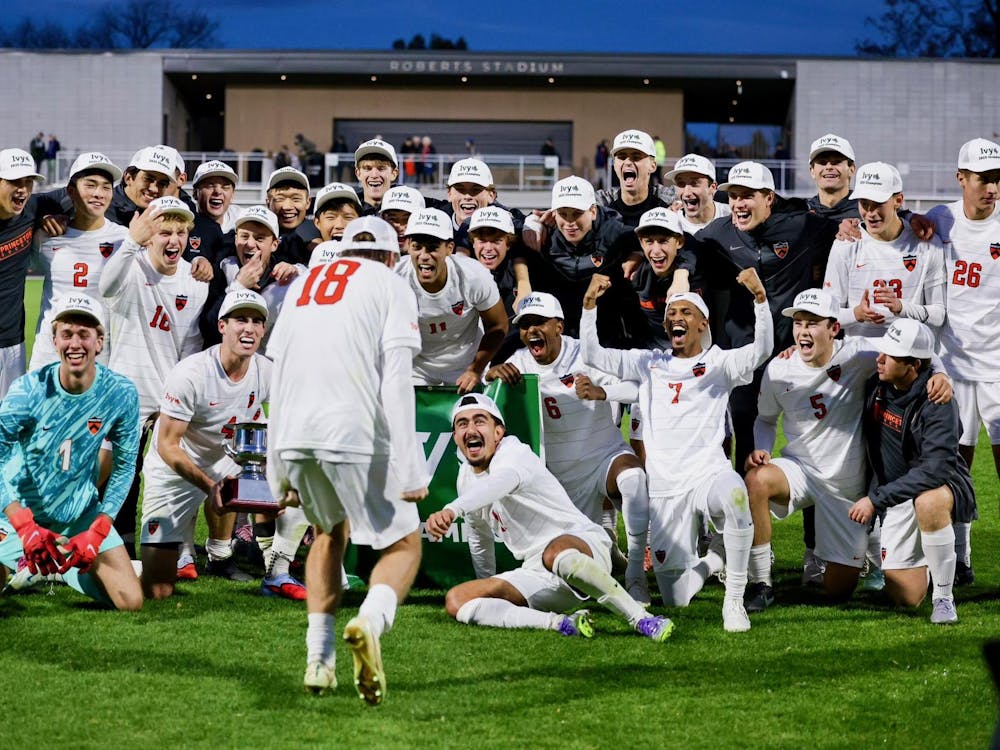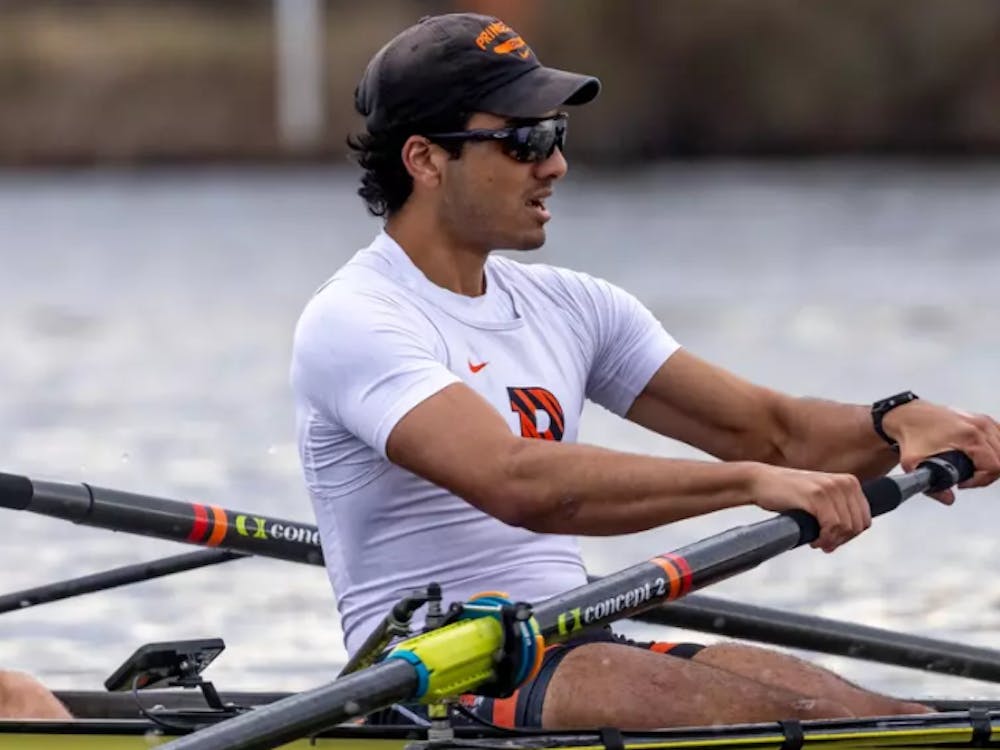The welcome banquet two days before the 2006 Lake Placid Ironman Triathlon was an environment unlike anything sophomore Laura Adams had ever experienced. Across from her sat a woman who had completed 16 Ironman Triathlons, and beside her was a man who was attempting the race again after failing to finish the previous year.
Adams, who was not only competing in her first Ironman, but also her first triathlon, described the environment as one full of "energy," where "everyone had a different story to share."
After showing an inspirational video, the emcee made a surprise announcement.
"Here is my favorite part of the night, because these athletes never expect this is coming," he said. "We're going to call up the youngest and oldest competitors in the race. So, Laura Adams from Great Falls, Va., are you here?"
Surprised and slightly embarrassed, Adams made her way up to the stage in front of the huge jumbotron before the crowd of people, where she was interviewed about the reasons she had chosen to pursue an Ironman.
"People found it pretty amusing that I had never been a runner or even done a triathlon before," Adams admitted.
Adams, a varsity field hockey and lacrosse player at Thomas Jefferson High School in Alexandria, Va., describes herself as an athletic person who has "always played all different kinds of sports." The summer prior to enrolling at Princeton, she and her family spent time at their house on Lake Champlain preceding the 2005 Lake Placid Ironman competition.
"My dad and I were driving through town the day before the race, and it was unbelievable," she said. "There were athletes everywhere. My father and I are both really competitive and goal oriented — we kept thinking about how cool it would be to finish an Ironman."
That evening, Adams and her dad spoke to a race volunteer who mentioned that registration for the following year's Ironman filled up 36 hours after midnight on the day of the race. With little time to ponder the decision and the thought that it was now or never, they both signed up for the 2006 event.
"I think the concept of doing an Ironman was really exciting at first," Adams said.
Prior to arriving at Princeton, she purchased a road bike. As she was paying for the bike herself, she opted for the least expensive option that would get her through the race.
"When we arrived at the Ironman, it was funny to see the expensive equipment people had bought," Adams said. "Most people have special aerodynamic wheels on their bikes. We joked that one of their wheels was twice the cost of my bike."

Upon arriving at school, she began to train on her own by running, swimming and cycling. She quickly found that while she didn't mind the long runs and swim sessions, she wasn't fond of biking. At school, Adams found that training for an Ironman helped her maintain athletic goals and allowed her to keep her focus as she was no longer playing a varsity sport.
As the year progressed, she followed a training program outlined in "Be Iron Fit," written by Don Fink, who has completed 30 Ironman Triathlons. The book suggested a 30-week training program in three phases: a base phase for general endurance, a build phase for improvement and a peak phase which involved significant runs and bike routes. Choosing to extend the base phase of training, Adams trained for nearly one year for the big race.
Training by herself during the school year was lonely.
"I had friends who would train with me for parts of my runs or swims, but no one really wanted to go for as long as I was going," she admitted. Extensive training also limited her social life.
"So much training isn't really conducive to the college schedule," Adams said. "I would wake up really early in the morning to do my bike rides and runs, but then I wouldn't really be able to hang out with friends in the evening. Sometimes, I would just sacrifice sleep." Toward the end of the school year, she suffered from a hip injury which kept her from running for about seven weeks.
"That really made me worried," she admits. "But luckily, I was able to build my running base back up."
Adams arrived home to perform most of the peak training phase with her father. "It was really nice to have someone else to train with," she said.
Their hardest day of training involved an intense 105-mile bike ride on Skyland Drive on the ridge of Shenandoah Valley. It was a sunny 95 degrees out without humidity as Adams and her father spent hours on the route navigating steep uphill climbs with downhill drops in between.
"We would climb for maybe 50 minutes, and then we would hit a short sharp decline for three or four minutes before going back to another hour of steep climbing," Adams said. "And sometimes the downhills were more terrifying than the uphills, because you're traveling at 35 to 40 mph."
This training run helped them prepare for the cycling leg of Lake Placid, widely known as one of the most difficult in an Ironman.
After a three-week taper and three days rest prior to the race start, Adams, her father and best friend from home traveled up to Lake Placid. The night before the race was full of anxiety.
"It was hard to sleep, I had such an adrenaline rush," Adams explained. "You do all of this training, and then the day finally arrives. I was almost grateful when the alarm went off at 4:45, and I could actually get out of bed."
At 7 a.m., a cannon boom signaled the start of the race for the 2,200 participants in a mass start at the swim. Adams completed the two-lap swim in just over an hour and then met with a welcome surprise — her whole family cheering for her at the swimming to cycling transition.
She continued moving through the legs of the race. Prior to starting, her greatest fear had been not finishing, but now she was amazed at how her training was paying off. Completing the two 56-mile bike loops through the mountains, she headed into the two 13.1-mile run loops around Lake Placid. She munched on gels and power bars provided by aid stations, along with peanut butter and banana sandwiches in the transition phases. Along the way, her fellow racers recognized her from the welcome ceremony only a few days before.
"You're doing great, Laura — you're the youngest one in the race! Keep it up," they cheered.
Adams eventually crossed the finish line in just over 13 hours, with her father finishing about 15 minutes behind her. She finished third among women aged 18 to 24.
Running up the home stretch towards the finish tape, she thought about how far she had come, and how it was her faith in God which helped carry her through.
"I kept thinking of how everyone says actually completing an Ironman isn't 'humanly possible' — that it's psychotic, ridiculous and unattainable," she said. "Somewhere along the way, I realized that the only way I was going to finish was going to be through God's grace. The coolest part was being able to rely on God through the process and finish through His help."
Adams admits that coming back to Princeton this year without something to train for has made her feel "a little lost." While she hopes to do another Ironman before she turns 24, she admits it will likely not happen while she is still at Princeton.
"It's a big commitment which I took very lightly — I would advise putting more thought into it," she says. "But I'm glad I did it now. It's easily the coolest thing I've ever done."







